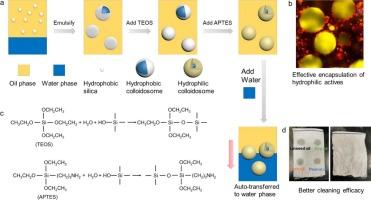Facile synthesis of Colloidosomes with tunable hydrophilicity as carriers of hydrophilic active ingredients for aqueous medium-oriented applications
IF 9.7
1区 化学
Q1 CHEMISTRY, PHYSICAL
引用次数: 0
Abstract
Colloidosomes have garnered significant interest as carriers for the controlled delivery of active ingredients across diverse applications. Nevertheless, effectively encapsulating hydrophilic actives within colloidosomes while maintaining their stability in aqueous medium without leakage remains a significant challenge. This arises from the high permeability of colloidosomes and the hydrophilicity mismatch between the carriers and the aqueous medium. Herein, we report a facile approach to the synthesis of colloidosomes with excellent sealing performance and tunable hydrophilicity. Our approach is based on the silica-stabilized Pickering emulsion templating, interfacial sol-gel reaction of TEOS and subsequent APTES grafting for surface hydrophilic modification. The size of colloidosomes agrees with the Pickering emulsion droplet and can be adjusted by changing the amount of silica. Notably, unlike other reported colloidosomes, the hydrophilicity of the synthesized colloidosomes can be controlled through the addition amount of APTES and their transfer into an aqueous medium can be readily achieved without any other steps. The colloidosomes demonstrated efficient encapsulation of hydrophilic active ingredients and feature a robust shell, enabling the high retention of enzyme activity (lipase) in practical liquid detergent applications. In contrast with unencapsulated lipase, colloidosome-encapsulated lipase demonstrated superior cleaning efficacy. This colloidosomes proposed in this study offers distinct advantages for the encapsulation and protection of hydrophilic active ingredients and shows great potential in detergents industry.

作为亲水活性成分载体的可调亲水性胶体体的简易合成。
胶体体已经获得了显著的兴趣作为载体的有效成分在不同的应用控制交付。然而,如何有效地将亲水性活性包裹在胶体体内,同时保持其在水介质中的稳定性而不泄漏,仍然是一个重大的挑战。这是由于胶体体的高渗透性和载体与水介质之间的亲水性不匹配。在此,我们报告了一种简单的方法来合成胶体体具有优异的密封性能和可调的亲水性。我们的方法是基于硅稳定的Pickering乳液模板,TEOS的界面溶胶-凝胶反应和随后的APTES接枝进行表面亲水性改性。胶体体的大小与皮克林乳滴一致,可以通过改变二氧化硅的量来调节。值得注意的是,与其他报道的胶体体不同,合成的胶体体的亲水性可以通过添加APTES的量来控制,并且可以很容易地将其转移到水介质中,而无需任何其他步骤。胶体体展示了亲水性活性成分的有效封装,并具有坚固的外壳,使酶活性(脂肪酶)在实际液体洗涤剂应用中的高保留。与未包封的脂肪酶相比,胶质体包封的脂肪酶表现出更好的清洁效果。本研究提出的胶体体对亲水活性成分的包封和保护具有明显的优势,在洗涤剂工业中具有很大的应用潜力。
本文章由计算机程序翻译,如有差异,请以英文原文为准。
求助全文
约1分钟内获得全文
求助全文
来源期刊
CiteScore
16.10
自引率
7.10%
发文量
2568
审稿时长
2 months
期刊介绍:
The Journal of Colloid and Interface Science publishes original research findings on the fundamental principles of colloid and interface science, as well as innovative applications in various fields. The criteria for publication include impact, quality, novelty, and originality.
Emphasis:
The journal emphasizes fundamental scientific innovation within the following categories:
A.Colloidal Materials and Nanomaterials
B.Soft Colloidal and Self-Assembly Systems
C.Adsorption, Catalysis, and Electrochemistry
D.Interfacial Processes, Capillarity, and Wetting
E.Biomaterials and Nanomedicine
F.Energy Conversion and Storage, and Environmental Technologies

 求助内容:
求助内容: 应助结果提醒方式:
应助结果提醒方式:


